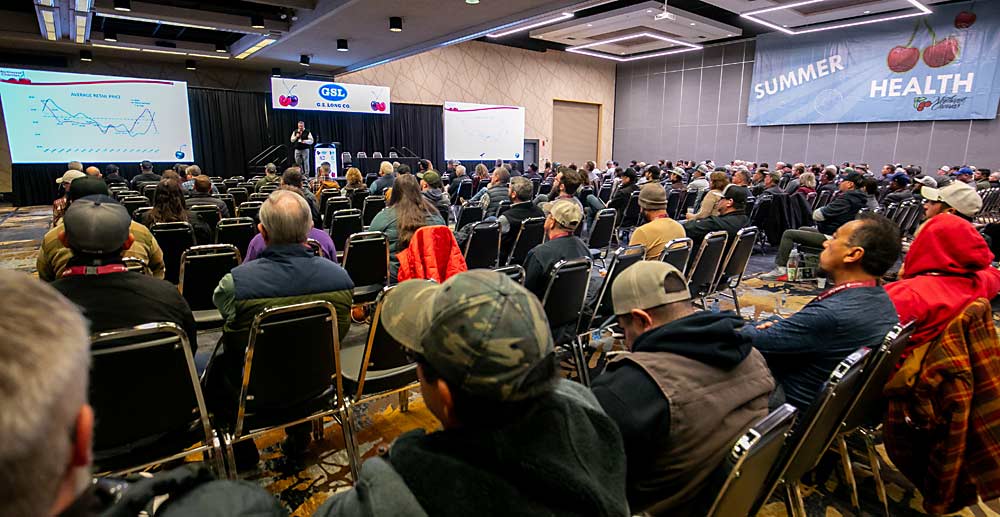
Administrators of Northwest Cherries told growers Jan. 10 at the 82nd annual Cherry Institute in Yakima, Washington, that the 2024 season was successful in shipping and promotions, a welcome bright spot after several tough years.
“Because you guys grew great cherries, it was a pretty good season,” said B.J. Thurlby, president of Northwest Cherries.
The 2024 crop delivered a volume in line with the five-year average of large fruit, Thurlby said. About 90 percent of cherries shipped in 2024 were 10.5 row or larger. Also, the shipment season was spread out more than in 2023 and did not overlap with California nearly as much, helping keep prices higher.
Karley Lange, director of domestic operations, and Keith Hu, director of international operations, told growers that the Ooh La La promotional campaign — a nod to the 2024 Paris Olympics — was a hit in the United States and abroad. The two synchronized the campaign for the first time in about 20 years, they said.
Lange told growers the campaign reached an audience of 414.5 million views, which includes digital and print media, nutrition newsletters, influencer campaigns and recipes. Health messaging — such as the research showing cherries reduce inflammation — permeated the content.
Lange also organized a localized promotion by setting up a special cherry-focused menu at Troutdale, Oregon, restaurant Sugarpine Drive-In. The Cherries Jubilee ice cream desert was mentioned in the New York Times.
The future goal is to reach younger people and families, Lange said. Market research tells her the average age of the cherry consumer is between 55 and 65.
The look of the campaign was anchored by an image of a young red-haired woman extremely happy about the snack of cherries she holds in her hand.
“The redhead is everywhere,” said Hu. He convinced transportation officials in and around Bangkok, Thailand, to wrap commuter trains in the imagery, as well as light up the stations with the promotions.
“I’m planning to use the redhead for two more years,” Hu said.
Per McCord, the Washington State University cherry breeder, told growers that the R19, one of three new cherry varieties in Phase 3 trials, may be released and available for tree delivery in 2027. The self-fertile Benton/Selah cross harvests in early June, about the same time as Chelan, but is firmer, larger and sweeter.
Kate Tynan, senior vice president of the Northwest Horticultural Council, shared updates — including some encouraging news — about H-2A regulations.
“This is one of the few times I actually have some good news to share,” she said.
One bit of that good news: President-elect Donald Trump’s selection for the U.S. Department of Labor is Lori Chavez-DeRemer, a former [R1] [JM2] Republican Congresswoman from Oregon. She is a fan of the H-2A program, has a background in agriculture and favors policies that line up with those of the fruit industry, Tynan said.
Meanwhile, three federal judges have applied the brakes to new H-2A regulations that were supposed to take effect in August last year. Among them is a stipulation that would remove a lot of flexibility for employers to toggle between piece rate and hourly wages, depending on the task. The court cases continue.
Cherry King crowned
At lunch, the cherry industry celebrated with the crowning of the 2025 Cherry King. Mike Taylor of Stemilt Growers, the 2024 Cherry King, presented the crown to plant pathologist Gary Grove who spent 38 years at Washington State University working to help cherry growers manage powdery mildew.
“You might not know this year’s Cherry King, but his work is (felt) on your bottom line,” Taylor said. “Mildew is a curse, and when it’s bad, it’s a killer. It’s tough on the receiver, it’s tough on the grower and it’s hard on the packing room — and so the work you have done is tremendous.”

Grove, a native of Ohio, followed his plant pathology degree west to a postdoctoral research position at the University of California, Davis, and embarked on cherry powdery mildew research when he joined WSU in 1986. He retired at the end of 2024, but he came to the Cherry Institute to give a few final talks on the lessons learned during his career before heading to the Caribbean to follow his passion for scuba diving.
Before his crowning, Grove told growers that the key to managing powdery mildew is strong year-over-year management through carefully planned spray programs that manage for the development of resistance and are applied with good coverage.
“The best way to minimize the overwintering inoculum going into the growing season of 2025 is to have effectively managed it in 2024,” Grove said. “It’s an ongoing process linked through years.”
Grove also thanked the industry for the recognition and the collaboration over the years.
“It means the world to me,” he said. “I don’t think I ever had anyone say no to me when I asked for a place to do cooperative research.”
Keynote speech
During the lunchtime keynote speech, Walt Duflock, vice president of innovation for Western Growers in California, gave a sobering assessment of agricultural policy and automation for his state, warning similar policies could have similar effects in Washington. For one, agricultural acreage has been decreasing in California but rising rapidly in Peru, where the federal government invests in water storage, and a middle class of farmers is growing. Not surprisingly, he said, the value of Peru’s ag exports has increased 21-fold over the past 20 years.

Duflock steers Western Growers’ efforts to help specialty crops in the West automate.
“If we don’t do that, acreage is going to move,” he said.
—by Ross Courtney






Leave A Comment